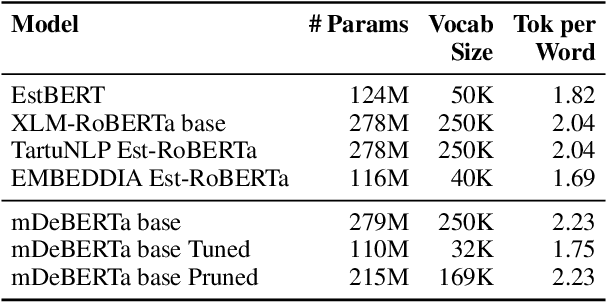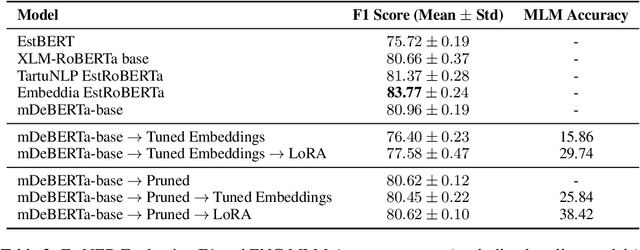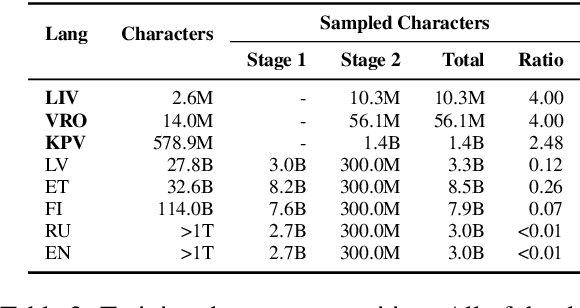Taido Purason
Prune or Retrain: Optimizing the Vocabulary of Multilingual Models for Estonian
Jan 05, 2025

Abstract:Adapting multilingual language models to specific languages can enhance both their efficiency and performance. In this study, we explore how modifying the vocabulary of a multilingual encoder model to better suit the Estonian language affects its downstream performance on the Named Entity Recognition (NER) task. The motivations for adjusting the vocabulary are twofold: practical benefits affecting the computational cost, such as reducing the input sequence length and the model size, and performance enhancements by tailoring the vocabulary to the particular language. We evaluate the effectiveness of two vocabulary adaptation approaches -- retraining the tokenizer and pruning unused tokens -- and assess their impact on the model's performance, particularly after continual training. While retraining the tokenizer degraded the performance of the NER task, suggesting that longer embedding tuning might be needed, we observed no negative effects on pruning.
LLMs for Extremely Low-Resource Finno-Ugric Languages
Oct 24, 2024



Abstract:The advancement of large language models (LLMs) has predominantly focused on high-resource languages, leaving low-resource languages, such as those in the Finno-Ugric family, significantly underrepresented. This paper addresses this gap by focusing on V\~oro, Livonian, and Komi. We cover almost the entire cycle of LLM creation, from data collection to instruction tuning and evaluation. Our contributions include developing multilingual base and instruction-tuned models; creating evaluation benchmarks, including the smugri-MT-bench multi-turn conversational benchmark; and conducting human evaluation. We intend for this work to promote linguistic diversity, ensuring that lesser-resourced languages can benefit from advancements in NLP.
Teaching Llama a New Language Through Cross-Lingual Knowledge Transfer
Apr 05, 2024Abstract:This paper explores cost-efficient methods to adapt pretrained Large Language Models (LLMs) to new lower-resource languages, with a specific focus on Estonian. Leveraging the Llama 2 model, we investigate the impact of combining cross-lingual instruction-tuning with additional monolingual pretraining. Our results demonstrate that even a relatively small amount of additional monolingual pretraining followed by cross-lingual instruction-tuning significantly enhances results on Estonian. Furthermore, we showcase cross-lingual knowledge transfer from high-quality English instructions to Estonian, resulting in improvements in commonsense reasoning and multi-turn conversation capabilities. Our best model, named \textsc{Llammas}, represents the first open-source instruction-following LLM for Estonian. Additionally, we publish Alpaca-est, the first general task instruction dataset for Estonia. These contributions mark the initial progress in the direction of developing open-source LLMs for Estonian.
To Err Is Human, but Llamas Can Learn It Too
Mar 08, 2024



Abstract:This study explores enhancing grammatical error correction (GEC) through artificial error generation (AEG) using language models (LMs). Specifically, we fine-tune Llama 2-based LMs for error generation and find that this approach yields synthetic errors akin to human errors. Next, we train GEC Llama models with the help of these artificial errors and outperform previous state-of-the-art error correction models, with gains ranging between 0.8 and 6 F0.5 points across all tested languages (German, Ukrainian, and Estonian). Moreover, we demonstrate that generating errors by fine-tuning smaller sequence-to-sequence models and prompting large commercial LMs (GPT-3.5 and GPT-4) also results in synthetic errors beneficially affecting error generation models.
 Add to Chrome
Add to Chrome Add to Firefox
Add to Firefox Add to Edge
Add to Edge